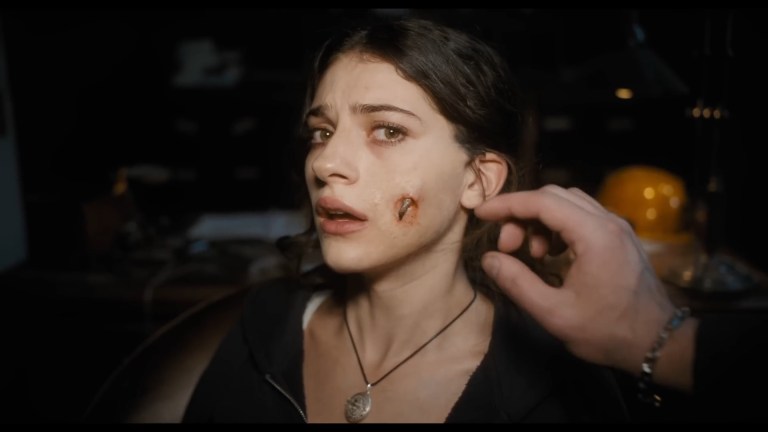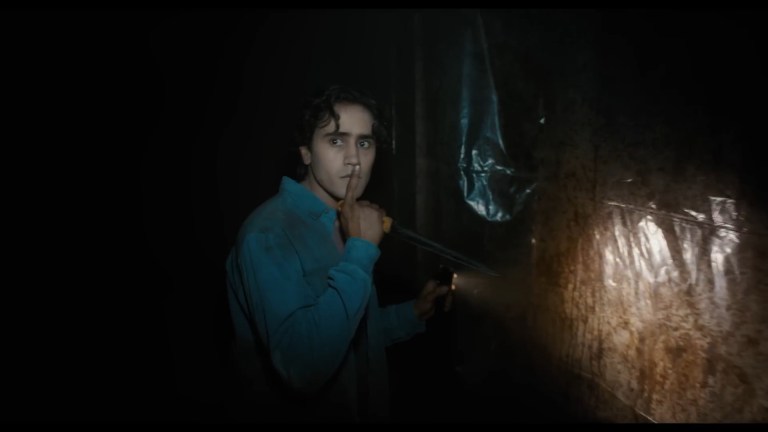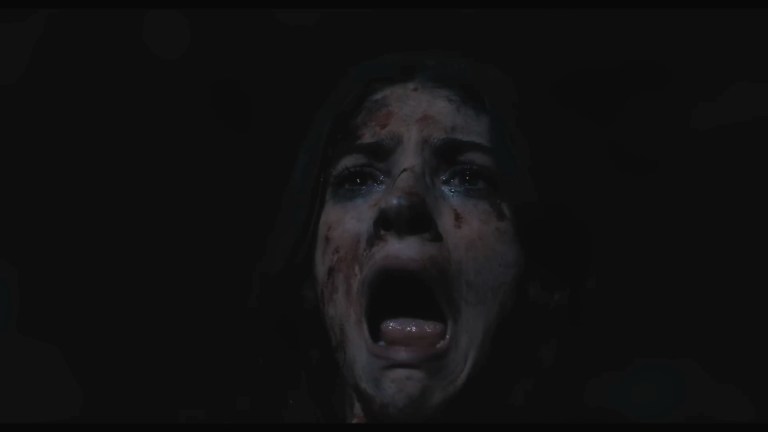‘Until Dawn’ Completely Misses the Point of the Video Game it Adapts: A Review
Using a time loop narrative takes away the most unique aspect of the game.

Table of Contents
What is Until Dawn About?

Until Dawn significantly deviates from the game it’s adapting, opting for a time-loop narrative in which five friends try to solve a mystery while enduring repeated variations of the same deadly night.
Clover and four of her friends travel to the small town of Glore Valley. Clover is searching for her missing sister Melanie, and a tip leads them to a visitors center where Melanie was known to be. During their first night there, they’re all killed by a masked man. Then they wake up. It’s earlier in the night and somehow they’re alive. The night repeats, but this time something else is trying to kill them. The night repeats again and again as Clover and her friends attempt to break the cycle for good and escape with their lives.
Until Dawn was directed by David F. Sandberg (Lights Out, Annabelle: Creation), and it was written by Gary Dauberman (‘Salem’s Lot, Annabelle Comes Home) and Blair Butler (Polaroid, Hell Fest). Ella Rubin stars as Clover. Her psychic friend Megan is played by Ji-young Yoo, her ex-boyfriend Max is Michael Cimino, her friend Nina is Odessa A’zion, and Nina’s boyfriend Abe is Belmont Cameli. Peter Stormare, who was in the original game, is also featured in a prominent role in the movie.
Until Dawn Review: Pretty Good to Not Very Good

When I first saw the trailer for Until Dawn, I thought the fundamental idea of it sounded dumb. After finally seeing the movie, my initial thoughts were confirmed. However, I will concede that I didn’t completely dislike everything. I’m actually of three minds about the film. Looking at it from three different points of view, Until Dawn is pretty good, not very good, and awful. I’ll explain each of these in descending order.
First, Until Dawn is pretty good if all you’re looking for is a fun collection of kill scenes with barely any context. If you’ve seen the trailers for the movie, then you already know what I’m talking about. The violence is bloody and brutal, and the monster/killer designs are quite good. There are even direct visual adaptations of characters from the game like the psycho and the wendigos. They’re creepy and cool, and the violence they enact is fun to watch.

There are also other monsters included in the movie, and there are other ways of dying. It’s like the writers came up with a bunch of ideas and didn’t want to toss any of them out, so they simply found ways to put them all in. Which, oddly, also leads to a segment of the film where we’re literally just watching videos of kill scenes along with the characters in the movie. It’s ridiculous, but it’s fine. I enjoy cheesy and bloody horror movies. It’s all pretty good.
What is not very good in Until Dawn is the story. It barely goes anywhere, and the stakes are rendered almost completely inert because of the time loop scenario. Death doesn’t matter. Characters literally ask for death at certain points. And even a potential permadeath (which isn’t actually death, but something possibly worse) is underwhelming because of how late in the movie the idea is brought up, and because of how the rules are revealed by someone completely untrustworthy. Who knows if they’re telling the truth? There aren’t even any real emotional stakes, because Clover’s main goal at the beginning of the movie is brushed aside and mostly forgotten when survival and escape become the characters’ only purpose. Practically nothing is accomplished in Until Dawn.

Also, all of the characters are flat, defined only by simplistic, readily apparent traits. Clover is driven to find her sister, Max is driven by longing for Clover, Megan is the one who connects to the supernatural, etc. Every character is written as a function of the plot rather than as people who go through emotional journeys. They’re scared, sure, but almost all of the potential character progression in the movie is halted by the need to show more monsters and to explain a convoluted reason for the time loop. There’s not enough time for much else.
There is, however, some time put aside for loose connections to the video game. I won’t say what those connections are, but I will say that, as an adaptation, Until Dawn gets it completely wrong.
Until Dawn Review: An Awful Adaptation

Until Dawn the game is fantastic. It’s an interactive story that allows players to make choices for multiple characters. Those choices can lead to many tiny variations in the way scenes play out, and they can lead to death. When characters die, they stay dead. There is no time loop. The game moves on, and you don’t get a second chance.
The design of Until Dawn actually prohibits the player from saving before meaningful choices. You can’t save manually at all. You get one save file, and the game saves automatically. That way you can’t “save scum” and reload a save to make a different decision, and you can’t bank multiple saves along different paths.

The design is brilliant, because it makes every choice in the game feel agonizingly tense. Some decisions are instantly regrettable, but the ramifications of others might not be felt until long after they’re made. And you can’t go back and change them. In effect, you only get one chance to make it through the night.
You can start the game over, but you can start any game over. Starting over isn’t unique in video games, and it certainly isn’t unique to Until Dawn. But the writers of the movie apparently think it is, so they gamified their movie. Using a time loop narrative was a terrible decision that took away the most unique aspect of the game, the idea that choices matter and there is no coming back from them.

What’s utterly frustrating is that dialogue in the movie explains that it means more when you know you only have one chance. The writers know that, yet they gave their characters so many chances that they couldn’t even fit every night and every death into the script. It was wild hearing that line spoken in the movie (twice if I remember correctly). They knew how to make their movie better, but they chose not to.
Defenders of the time loop choice might argue that replaying the game to see all of the deaths and endings is part of the game’s draw, but I’d say it isn’t the main draw. Far from it. Going back to see all the scene and dialogue variations you missed is never as fun as that first playthrough. It actually gets rather tedious after a while, because you realize that there are only so many variations, and most of them are minor with regards to the overall story. The game boasts over 250 different endings, but again, almost every single difference is minor. So, no, replayability should not have been the thing the film adaptation latched on to. It should have paid attention to the tension created by not giving their characters multiple attempts at surviving.

One final note. I don’t mind that the movie didn’t try to adapt the story of the game. At least, not necessarily. Attempts are made in the movie to vaguely connect it to the game, but they don’t really work given the introduction of the time loop. So, since the rules of the world are different, and since the movie does not adapt the story of the game, the Until Dawn movie should have been something else entirely. A different movie with a different title. It ends up feeling like it’s just cashing in on the title and some of the visuals in order to get people to see it.
Until Dawn Rating and Recommendation

Star Rating: 2.5 out of 5
Writing this all out, I want to give an even lower star rating. As a big fan of the game, Until Dawn is a frustrating movie. But, some people might not be as bothered by the filmmakers’ fundamental misunderstanding of the main draw of the game. Also, people who haven’t played the game certainly won’t care about the change. As a relatively mindless series of brutal kills, Until Dawn is okay. Nothing great, but it’s visually appealing.
